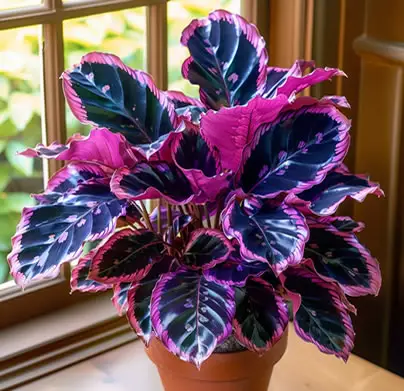Calathea Care: How To Keep Your Prayer Plant Thriving Indoors

With its striking foliage and rhythmic leaf movements, Calathea is one of the most captivating houseplants you can own. Known as the “prayer plant” (not to be confused with Maranta leuconeura), Calatheas are beloved for their vibrant leaf patterns and dynamic personality — but they do have a bit of a diva reputation.
Here’s your complete guide to Calathea care: how to keep it happy, healthy, and thriving in your home.
Table of Contents
- Finding the Perfect Light for Your Calathea’s Bold Leaves
- How to Water Calathea Without Drowning or Drying It Out
- The Secret to Happy Calatheas? Humidity, Humidity, Humidity
- Keep It Cozy: The Ideal Temperature Range for Calathea Plants
- What Soil Does a Calathea Crave? Create the Perfect Mix
- Feed Me Gently: The Right Fertilizer for Calathea Growth
- Trimming & Tending: Simple Calathea Maintenance Tips
- Brown Tips? Curling Leaves? Here’s How to Fix Calathea Problems
- Why Calatheas Move Like They’re Alive (Because They Kind of Are)
- Final Word
Finding the Perfect Light for Your Calathea’s Bold Leaves
Calatheas thrive in bright, indirect light.
Direct sun can scorch their delicate leaves, while low light will cause the patterns to fade.
Ideal Location: Near an east- or north-facing window, or behind sheer curtains in brighter rooms.
Avoid harsh afternoon sun.
How to Water Calathea Without Drowning or Drying It Out
Calatheas are moisture lovers but absolutely hate soggy soil.

The key is balance.
-
Water when the top inch of soil feels dry.
-
Use filtered or distilled water if possible — Calatheas are sensitive to minerals and fluoride in tap water.
-
Reduce watering slightly in winter, but never let the soil fully dry out.
Pro tip: Yellowing leaves often mean overwatering.
Crispy edges signal underwatering or water quality issues.
The Secret to Happy Calatheas? Humidity, Humidity, Humidity
This is where Calatheas earn their diva status.
-
Calatheas need high humidity — at least 50%, but ideally 60–70%.
-
Group them with other plants, use a humidifier, or place them on a pebble tray.
-
Avoid placing them near heaters or air vents.
Keep It Cozy: The Ideal Temperature Range for Calathea Plants
Keep your Calathea in a warm, stable environment:
-
Ideal range: 65–80°F (18–27°C)
-
Avoid: Sudden drafts, cold windowsills, or temps below 60°F (15°C)
What Soil Does a Calathea Crave? Create the Perfect Mix
Use a well-draining, moisture-retentive soil mix.
Think rich but breathable.
Suggested Mix:
-
2 parts peat or coco coir
-
1 part perlite
-
1 part orchid bark or compost
Repot every 1–2 years, preferably in spring.
Feed Me Gently: The Right Fertilizer for Calathea Growth
While Calatheas aren’t heavy feeders, a little nutrition boost can enhance their growth and color — especially during spring and summer.
-
Frequency: Once a month during the growing season (spring to early autumn).
-
Use a balanced fertilizer with an N-P-K ratio of:
3-1-2 or 10-10-10
-
Type: Use a balanced, water-soluble houseplant fertilizer diluted to half strength.
-
Avoid: Fertilizing in winter when the plant is dormant — it can lead to root stress or leaf burn.
-
Watch for: Leaf tip browning or yellowing after feeding — this may mean your fertilizer is too strong or being applied too often.
Optional: Consider a gentle organic option like worm castings or a kelp-based liquid feed if you want to go natural.
Pro Tip: Avoid high-nitrogen formulas (like 20-10-10) — these can cause weak stems and leaf browning over time.
Trimming & Tending: Simple Calathea Maintenance Tips
-
Remove any yellow or brown leaves at the base.
-
Wipe the leaves with a damp cloth occasionally to keep them dust-free.
-
Avoid misting directly on the leaves, especially in low airflow areas.
Brown Tips? Curling Leaves? Here’s How to Fix Calathea Problems

-
Brown edges or tips: Low humidity or poor water quality
-
Drooping leaves: Often reversible with water or humidity boost
-
Fading leaf patterns: Insufficient light
-
Curling leaves: Could be underwatering or cold exposure
Pests: Watch for spider mites, thrips, and fungus gnats.
Neem oil or insecticidal soap, like this one, usually does the trick.
Why Calatheas Move Like They’re Alive (Because They Kind of Are)
Calatheas “pray” — their leaves fold up at night and spread out during the day.
This daily movement is part of a process called nyctinasty and signals a happy, healthy plant.
Final Word
Calatheas may be a bit dramatic, but they’re well worth the effort.
With the right humidity, filtered water, and a little attention, they’ll reward you with bold foliage and mesmerizing movements.
If you’ve mastered the basics, explore stunning varieties like Calathea orbifolia, Calathea medallion, or Calathea lancifolia (rattlesnake plant) — each with their own unique flair.
Thanks for reading! I'm Michael — houseplant fanatic and your Pinterest plant guide.
Follow me on Pinterest for fresh updates 🌿



